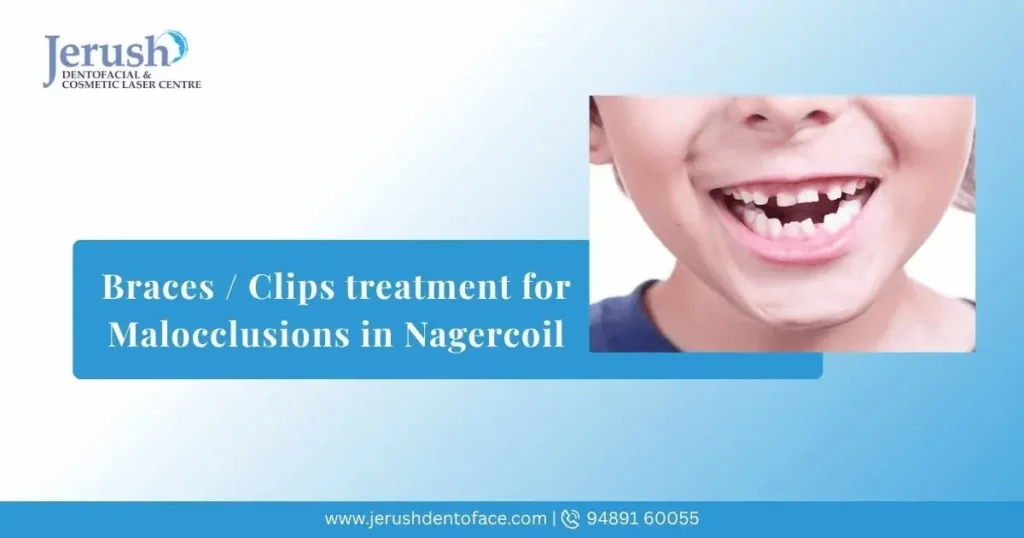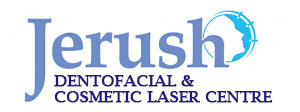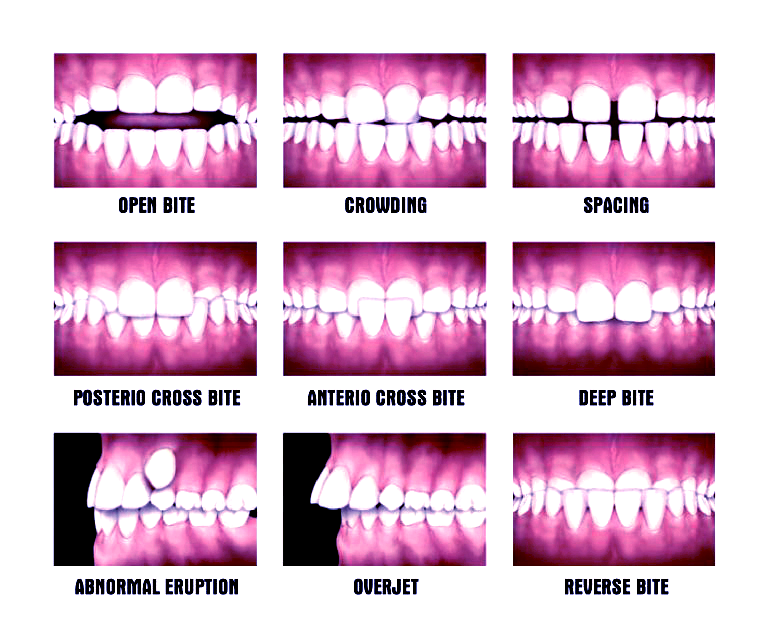
Braces / Clips treatment for Malocclusions in Nagercoil
What is Dental Malocclusion?
Dental malocclusion means the abnormal alignment of the upper and lower teeth. At Jerush Dental & Facial Corrective Centre, Chennai, we specialize in diagnosing and treating dental malocclusion with advanced braces and clips treatment.
Causes of Malocclusion
Types of Dental Malocclusion
1. Overjet
The upper front teeth protrude outward, extending beyond the lower teeth.
2. Overbite
Excessive vertical overlap of the upper teeth over the lower teeth.
3. Anterior Crossbite (Underbite)
Lower front teeth protrude beyond the upper front teeth.
4. Spacing
Visible gaps between teeth.
5. Diastema
A specific form of spacing, often between the upper front teeth.
6. Missing Teeth
Spaces caused by the absence of one or more teeth.
7. Impacted Tooth
A tooth that fails to emerge properly.
Angle's Classification of Malocclusion
History of Malocclusion Classification
In 1894, Edward H. Angle published the first scientific classification of dental malocclusion.
Class I Malocclusion: Neutrocclusion
It is the most common malocclusion with a normal bite and light overlap of teeth.
Molar relation: The mesiobuccal cusp of the upper first permanent molar occludes with the mesiobuccal groove of the lower first molar. But the line of the occlusion is altered in both arches because of individual tooth irregularities, such as: Crowding, Spacing, Rotations of other localized problems of the tooth, Inter-arch problems like open bite, deep bite, crossbite
- • Crowding
- • Spacing
- • Rotations
- • Open bite, deep bite, crossbite
Class II Malocclusion: Distocclusion / Retrognathism / Overbite
The top jaw and enamel critically overlap the decrease jaw and tooth.
Molar relation: The mesiobuccal cusp of the maxillary first premolar occludes mesially to the mesiobuccal groove of the mandibular first molar.
Class II Division I
- • Upper incisors are proclined,
- • Excessive overjet and deep overbite
- • V-shaped upper dental arch
- • Difficulty closing the lips
Class II Division II
- • Upper central incisors show lingual inclination, often overlapped by upper lateral incisors
- • Deep overbite
- • Broad upper dental arch,
- • Normal lip seal with a deep mental groove
Class III Malocclusion: Mesiocclusion / Prognathism / Anterior Crossbite / Negative Overjet / Underbite
The lower jaw protrudes forward, causing the lower enamel to overlap the upper tooth.
Molar relation: The mesiobuccal cusp of the maxillary first premolar occludes distally to the mesiobuccal groove of the mandibular first premolar.
Treatment Options for Malocclusion at Jerush Dental & Facial Corrective Centre, Nagercoil
Class I Malocclusion Treatment
- • Fixed orthodontic braces correct crowding and spacing.
- • Time frame: six months to a year.
May include:
- • Extraction of teeth to correct overcrowding
- • Jaw contouring surgery
- • Stabilizing wires or plates for jaw bone alignment
Class II Malocclusion Treatment
- • Orthodontic braces
- • Conventional orthodontics
- • Surgical intervention for severe cases
- • Correction for retrognathic mandible
Class III Malocclusion Treatment
- • Combination of orthodontics and orthognathic surgery
- • Fixed orthodontic braces (camouflage treatment)
- • Use of mouthguards
- • Treatment duration: 1 year, followed by retainers for bone stabilization
Advanced Braces and Clips Treatment Options in Nagercoil
Metal Braces:
Affordable and durable, effective for complex cases.
Ceramic Braces:
Tooth-colored brackets for aesthetic appeal.
Self-Ligating Braces:
Friction-free, faster treatment with less discomfort.
Lingual Braces
Invisible option with braces attached behind the teeth
Aligners, which are clear (invisible braces)
Teenagers and Nagercoil operating specialists may utilize the removable, transparent trays.
Treatment Time and Aftercare for Braces
- • The course of treatment lasts anywhere from six months to two years.
- • For best results, follow-ups must be done regularly.
- • To avoid relapse, retainers must be worn following treatment.
Service Areas Near Thuckalay Branch
Jerush Dental & Facial Corrective Center, Thuckalay is conveniently located just 20 minutes from: Nagercoil, Marthandam, Kaliyakkavilai, Kulasekharam, Colachel, Karungal, Monday Market, Eraniel, and Parvathipuram.
FAQ
Q1. What reasons for malocclusion?
Childhood conduct, more or presence of teeth, impacted teeth, and genetic factors contribute to malocclusion.
Q2. How long does a brace remedy take?
Typically, the remedy lasts from 6 months to 2 years, depending on the severity and type of malocclusion.
Q3. Are clear aligners powerful for malocclusion correction?
Yes, clear aligners are effective for mild to moderate malocclusions and are popular in Chennai, Trichy and Nagercoil
Q4. Are braces a remedy for pain?
Mild pain is normal, however plausible with pain relief medications and subsides within a few days.
Q5. What is the first-class age for braces?
The best age is between 10 to 14 years; however, adults can also acquire splendid results.
Author: Dr. Sangari, one of the Top Dentists in Jerush Dental & Facial Corrective Centre, with more than a decade of experience in dental patient care. Very patient-friendly, and anyone would feel like a neighborhood doctor. Dr. Sangari's long-term dedicated association in our center proved like an inevitable member among team surgeons, creating millions of happy smiles.


No Comments yet!